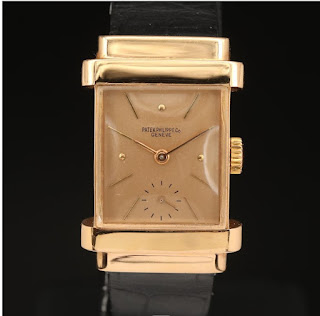When I began this pursuit of repairing, restoring, and building watches, I never thought it might one day involve any kind of high-end watch such as a Patek Philippe. But with the help of Karen, my treasure-hunting wife, a vintage Patek Philippe 1450 "Top Hat" manual wind watch became ours.
The watch was posted on the estate auction service Everything But the House (EBTH) and listed as "not running". The posting photos showed that the case, crystal, hands, and dial seemed to be in very fine condition. The movement appeared clean, without corrosion or damage, and the only really degraded part was the strap, which was black alligator with a (probably plated) yellow gold finish clasp. The rectangular case is 18k rose/pink gold with hooded lugs and matching dial and hands. The movement is a caliber 9-90, tonneau/barrel shaped, and manual wind. The crystal did not appear to match the cylindrical shape fitted to the original Top Hat per photos and images from the period Patek catalog. Despite much searching, I was unable to determine whether or not it might be original.
During the auction we researched the model and based on the movement serial number determined it was produced from 1940-1945, with this one likely in 1940. Listings for 5 matching items on Chrono24 were priced from $10,000 to $19,000, and the auction stood at $2200 with 2 days to go. We judged that many people would not want to risk investing in a watch with a bad movement, but I thought I would have a better chance than most to recover a reasonable price. In the end, we decided to go for it and won the auction at $4810 plus tax and fees. That weekend we drove the EBTH in Cincinnati to pick up the watch instead of having it shipped.
Once at home, I inspected it under the microscope looking for flaws. The case, dial, crown, and hands still looked excellent with very few scratches at all and no blemishes on the dial. Overall, amazing for an 83-year old watch. The strap and buckles were okay, but we would likely replace it anyway.
The one puzzling part was the crystal. Under examination I could see the face of the crystal was perfectly flat with squared, sharp edges and vertical sides. The underside, however, was concave, distorting (shrinking) any image seen through the crystal. No other online image of a Top Hat appeared to have this shape of crystal. Also, the material felt like glass or possibly sapphire, but definitely was not acrylic or other plastic as I understood the original model was.
I measured the crystal to see if I could find a close match from the sources I had identified back when I was working on the Hamilton Myron and the pendant watch. That's when I made a mistake -- I used my digital calipers to measure the outline of the crystal while mounted in the case, and the stainless steel jaws of the calipers scratched the very soft 18k solid gold of the watch case.
That was frustrating and led me down a path of researching how to polish scratches out of gold. It also led me to order a new digital caliper with plastic jaws.
I researched replacement crystals and found that G-S has an exact match acrylic model CX770 with cylindrical profile and correct dimensions (21.6 x 19.5 mm)





.jpg)

